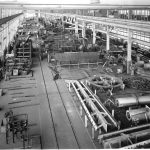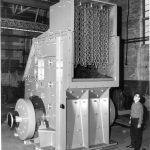As the prospect of war grew closer in 1940, BIW embarked on an ambitious shipyard expansion. The shipyard clearly needed more space, so a 15-acre site in East Brunswick, formerly home to a horse racing track, was purchased.
The site had been used as a steel storage yard during WWI, and BIW initially planned a similar use. However, under the leadership of John Newell, son of BIW President Pete Newell, plans for the Hardings facility quickly grew to include a full-scale steel fabrication plant with warehouses and auxiliary shops. The main shop building also included a large mold loft, measuring 750-feet by 90-feet, for full-scale lofting of ship drawings.
Construction of the new facility was funded by the Navy, but BIW didn’t wait for the formality of a contract. Ground was broken in July of 1940, and with wartime urgency, work was 70 percent complete by September when the contract was finally signed. When an officer arrived to inspect plans for the facility, he was instead given a tour of the nearly completed buildings. Hardings cut steel for the first time in December 1940, a full year before the attack on Pearl Harbor, and the facility was fully operational by the spring of 1941.
The Hardings facility initially employed 350 people, eventually reaching a wartime peak of 1,200 as the facility handled all steel storage, cutting, and subassembly fabrication for the main shipyard. In addition, Hardings provided the same services to the new South Portland shipyards, until their fabrication facilities came online.
After the busy wartime years, the workload at Hardings naturally declined. BIW purchased the facility from the Navy, making it a permanent part of the shipyard, and looked for alternative work to keep the shop busy. In the postwar years, BIW operated an industrial products division and purchased Pennsylvania Crusher Company, a manufacturer of rock-crushing machinery. These operations produced diverse equipment including beverage vending machines and mining equipment, enough to keep Hardings and other facilities running during slow periods.
Like the main shipyard, the Hardings facility has continued to evolve with the times. In the 1950s, semi-automatic plate-burning machines were installed, the predecessors of today’s modern burning tables. Over the years, additional shops have been added, the plate yard expanded, and in 1972 the monobox crane was constructed. More recently, Hardings saw significant upgrades in B-Bay, leading up to the current Digital Steel project.
While Hardings is now the oldest major BIW production facility, it remains the key first step in construction of every Bath-built ship.





